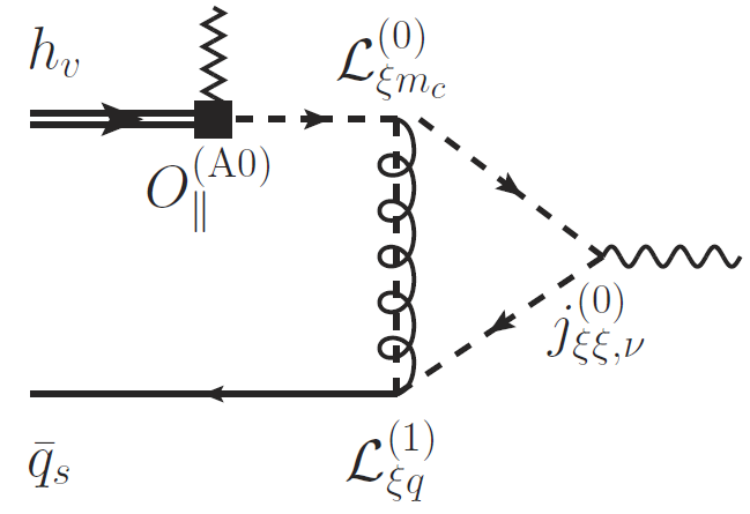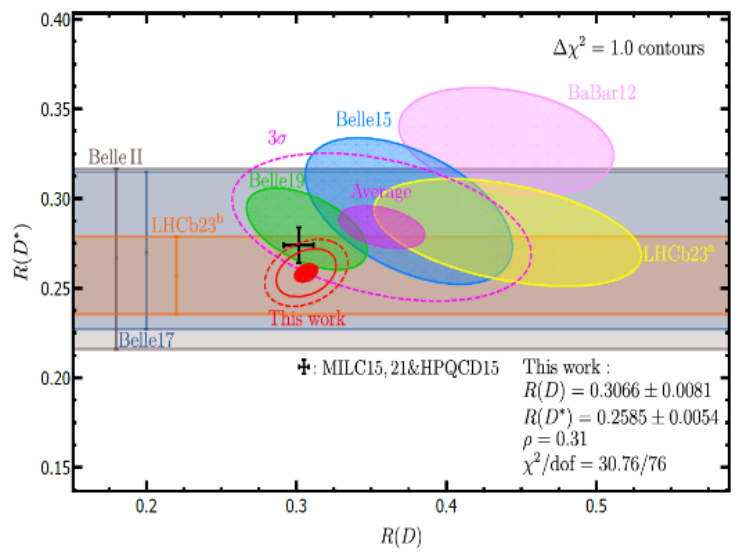NKU Team Makes Significant Progress in Unraveling the Dynamic Mechanism Dictating the Heavy-Meson Decay “Anomalies”
Professor Wang Yu-Ming from the School of Physics at Nankai University in collaboration with with a postdoctoral researcher (Cui Bo-Yan) and two doctoral students (Huang Yong-Kang and Zhao Xue-Chen), computed for the first time the next-to-leading-order (NLO) QCD corrections to the  form factors at large hadronic recoil. Both the charm-quark-mass- and the strange-quark-mass-dependent pieces could generate the leading-power contributions to these form factors. This is widely considered as a true theoretical breakthrough, going far beyond the Born-level computations of the relevant form factors achieved in 2008. Including further various power-suppressed contributions, the research team performed the combined fits of the above-mentioned form factors to both their large-recoil theory predictions and the lattice QCD results, thus improving upon the previous determinations of the lepton-flavor-universality ratios
form factors at large hadronic recoil. Both the charm-quark-mass- and the strange-quark-mass-dependent pieces could generate the leading-power contributions to these form factors. This is widely considered as a true theoretical breakthrough, going far beyond the Born-level computations of the relevant form factors achieved in 2008. Including further various power-suppressed contributions, the research team performed the combined fits of the above-mentioned form factors to both their large-recoil theory predictions and the lattice QCD results, thus improving upon the previous determinations of the lepton-flavor-universality ratios  significantly. Taking into account the obtained LCSR data points in the BGL z-series fit of the
significantly. Taking into account the obtained LCSR data points in the BGL z-series fit of the  form factors enabled them to significantly enhance the achieved accuracy of the large-recoil theory predictions for the
form factors enabled them to significantly enhance the achieved accuracy of the large-recoil theory predictions for the  form factors. Implementing the determined LCSR results in the statistical analysis turned out to be advantageous in mitigating the combined
form factors. Implementing the determined LCSR results in the statistical analysis turned out to be advantageous in mitigating the combined  and
and  tension between the SM predictions and the HFLAV-averaged measurements, which was reduced from 3.3
tension between the SM predictions and the HFLAV-averaged measurements, which was reduced from 3.3![]() to 2.6
to 2.6![]() (shown in the figure below). In addition, the research team systematically investigated four different types of power suppression effects at the tree level, based on the motion equation of the heavy quark efficiency theory and the amplitude of the higher-twist B-meson cone distribution. It was found that the two-particle B-meson (twist-5) light-cone distribution amplitude can bring about the important NLO power contributions phenomenologically. Their research is of particular importance in the field of high-order power corrections in form factors of the B→D (*)lν decay.
(shown in the figure below). In addition, the research team systematically investigated four different types of power suppression effects at the tree level, based on the motion equation of the heavy quark efficiency theory and the amplitude of the higher-twist B-meson cone distribution. It was found that the two-particle B-meson (twist-5) light-cone distribution amplitude can bring about the important NLO power contributions phenomenologically. Their research is of particular importance in the field of high-order power corrections in form factors of the B→D (*)lν decay.

Figure: Feynman diagram of the charm-quark mass induced effect

Figure: Theoretical prediction results of R (D (*))
It is worth mentioning that the recent research work of the NKU team was done on the basis of the theoretical work jointly completed by Professor Wang Yu-Ming, Professor Wei Yan-Bing from the Beijing University of Technology, Professor Shen Yue-Long from the Ocean University of China, and researcher Lu Cai-Dian from the Institute of High Energy Physics of the Chinese Academy of Sciences [JHEP 06 (2017) 062] (cited 64 times), as well as the research work jointly completed by Professor Wang Yu-Ming, Dr. Gao Jing (formerly a postdoctoral fellow from Nankai University), Professor Tobias Huber from the University of Siegen, Dr. Ji Yao from the Technical University of Munich, Professor Wang Chao from the Huaiyin Institute of Technology (formerly a postdoctoral fellow from Nankai University), and Professor Wei Yan-Bing (formerly a postdoctoral fellow from Nankai University) [JHEP 05 (2022) 024].
On October 20, 2023, the paper summarizing their research achievement with the title Shedding New Light on  and
and  from Semileptonic
from Semileptonic  Decays was published online in Physical Review D (Letter).
Decays was published online in Physical Review D (Letter).
Related links:
Physical Review Letters paper:
https://link.aps.org/doi/10.1103/PhysRevD.108.L071504
JHEP paper I:
https://link.springer.com/article/10.1007/JHEP06(2017)062
JHEP paper II:
https://link.springer.com/article/10.1007/JHEP05(2022)024
(Edited and translated by Nankai News Team.)









